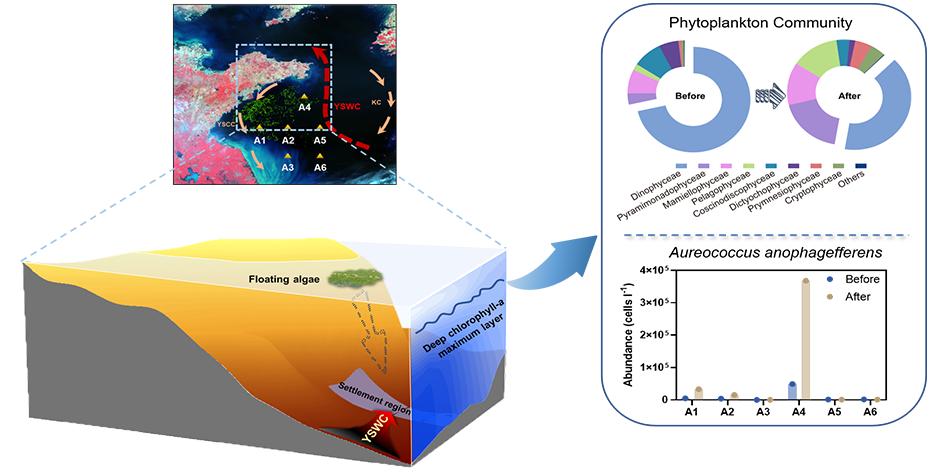Harmful algal blooms formed by fast-growing, ephemeral macroalgae have expanded worldwide. Since 2007, green tides formed by Ulva prolifera have been recorded in the Yellow Sea of China for 15 consecutive years, and have become a notable marine ecological problem.
During the bloom, massive green algae piled in the coastline of the southern Yellow Sea, which posed severe detrimental effects on social and economic activities such as tourism and marine aquaculture in coastal regions.
However, the knowledge on the potential ecological consequences of macroalgal blooms is quite limited.
The research team on harmful algal blooms and marine ecological security led by Prof. YU Rencheng of the Institute of Oceanology, Chinese Academy of Sciences (IOCAS), identified the settlement region of massive floating green algae and revealed the unique alteration of marine ecological environment in the settlement region under the influence of the decline of green tides.
The study was published in Environmental Science & Technology.
Using 28-isofucosterol in the surface sediment as a biomarker of green algae in genus Ulva, the settlement region of massive floating green algae was identified in the area southeast of the Shandong Peninsula in the Yellow Sea (36-36.5°N, 122-124°E).
Changes in the phytoplankton assemblage in the settlement region could be partially explained by the formation of the Yellow Sea Warm Current (YSWC), and the increased relative abundance of pelagophyte is most likely driven by the settlement and decomposition of massive floating green algae.
The responses of the phytoplankton assemblage from the deep chlorophyll-a maximum layer were then resolved using high-throughput sequencing and striking changes in the phytoplankton community in the settlement region were found after an intensive green tide in 2016, characterized by a remarkable increase in the abundance of the pelagophyte Aureococcus anophagefferens, which is the causative species of brown tides.
Brown tides of A. anophagefferens are typical ecosystem disruptive algal blooms (EDAB). Their occurrence along coasts of the Bohai Sea and the Yellow Sea led to severe deleterious impacts on the scallop (Argopecten irradians) mariculture and economic animal seedling incubation industry.
The study strongly suggests a linkage between green tides and brown tides in the Yellow Sea and Bohai Sea, and contributes to a more comprehensive understanding of the ecological consequences caused by green tides in the Yellow Sea.
The study was supported by the National Natural Science Foundation of China, Shandong Provincial Natural Science Foundation, the Marine S&T Fund of Shandong Province for Pilot National Laboratory for Marine Science and Technology (Qingdao), and the Science and Technology Basic Resources Investigation Program of China.

The settlement and decomposition of floating green algae promoted the proliferation of Aureococcus anophagefferens
Zhao JY, Geng HX, Zhang QC*, Li YF, Kong FZ, Yan T, Zhou MJ, Yang DZ, Yuan YQ, Yu RC*. (2022). Green tides in the Yellow Sea promoted the proliferation of pelagophyte Aureococcus anophagefferens. Environmental Science & Technology, doi.org/10.1021/acs.est.1c06502.
GENG Huixia
Institute of Oceanology
E-mail: hxgeng@qdio.ac.cn
(Editor: ZHANG Yiyi)
|
|

Address: 7 Nanhai Road, Qingdao, Shandong 266071, China
Tel: 86-532-82898902 Fax: 86-532-82898612 E-mail: iocas@qdio.ac.cn


